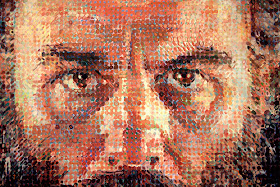Therein lies the problem. How do you describe something so unique? Here it goes- if you were to combine Shakespeare's MacBeth (plot), film noir (mood), Stanley Kubrik's Eyes Wide Shut (audience interaction) and the interpretation of modern dance (action), the result would be Sleep No More.
First, let me give you a little bit of history- Punchdrunk is a British immersive theater company that encourages the audience to choose what it sees by allowing them to walk through the space as the action takes place. The theater company was founded in 2000 and has won many awards for the unique experience it provides it's audiences.
For the NYC production of Sleep No More, Punchdrunk converted a warehouse that used to be a nightclub space into the "McKittrick Hotel". And this is the "hotel" we walked into:
 |
| The lobby |
 |
| the dining room |
 |
| Another room on the main level...I think, it was very dark : ) |
 |
| the telephone booths in the lounge |
 |
| another view of the lobby (photos by Stu Horvath) |
It all started in the lounge where you are asked to mingle and get a drink of champagne or absinthe while you wait. There was a three piece band and an English man directing groups of people to the hotel doorway, where a lady named "the Countess" would tell us about our "stay" at the McKittrick Hotel.
 |
| the lounge |
Around fifteen people went onto the elevator and we were all dropped off in smaller groups on various floors...except for me...I will get back to that later.
I started out on the top floor which was filled with room after room of "craziness"- a padded room with feathers ripped out of the padding and strewn across the floor, a room with a laid-back patient chair sitting beside a tray full of tools, a room with clotheslines full of white sheets, a room with lots of vintage looking baby dolls with their heads either ripped off or abused in some way. This is where I saw the room with all of the beds.
I went through a few rooms, before I encountered even one person, and when I finally did see another person, that person had a mask on. I about jumped out of my skin, before I realized they were probably just like me and had no idea what the hell was going on.
Finally I came upon a room full of eight claw-footed tubs. One was half-full of water. Right about then, I heard someone moaning and chanting unrecognizable words. A woman came around the corner with a nurse guiding her towards one of the tubs. The nurse proceeded to undress her and put her into the water. The woman who turns out to be Lady MacBeth started to bathe herself, the whole time mumbling incoherently. At one point she looked down and realized her hands, arms and legs were smeared with blood. She became frantic and tried to remove all evidence of the blood.
I have to say at that moment, I was completely entranced by what was happening in front of me, and the very next moment was spent looking at this sea of white distorted faces staring at a distraught nude woman bathing. She seemed so vulnerable- especially when she stood and stepped out of the tub and walked through the crowd of people. Acting as if she did not see even one of us.
 |
| (photo from Daily Front Row) |
 |
| (photo by Thom Kaine) |
I thought it was funny how some people in the audience acted as if the mask made them invisible. They would walk right up to the actors during a scene. They would lean over them as they were reading a letter, or peer into the tub as Lady MacBeth was bathing MacBeth.
Most of the action in the play was done through dance. One of the craziest things I saw was this girl who kept walking right up to the actors- MacBeth and Lady MacBeth were fighting/angrily spinning and flipping over one another on a bed. The girl sat at the foot of the bed right in the middle of their choreographed scene and got kicked off and landed on the floor. She got up and scooted back to the crowd, actors never pausing from their fight.
We had three hours in the hotel, and I can honestly say that the first hour-and-a-half was spent in complete confusion. I felt as if I was missing something crucial to my understanding of what was going on. I knew there were all of these things going on throughout the hotel and I was frustrated that I could only be in one place at a time. Thankfully, the play is run through twice so if you ever come upon a scene you have already seen, you can choose to follow the other person, the second time around. By the end, I felt as if all of the pieces were finally starting to make sense. I know that if I went to Sleep No More fifteen times, I would never have the same experience. That's the magic.
After the finale scene...
I exited the hotel and found myself in the lounge, where there were women singing 1930's songs and the tables were filled with people discussing the experiences they had had in the hotel.
Not until I found the two friends I went with, and started talking to them, did I realize how unique everyone's experiences were.
This is mine. Get ready for a lot of words- I have to paint the picture : )
Remember when I said I would get back to the elevator? When James, the elevator operator, told us he hoped we enjoyed our stay at the hotel, and the elevator stopped moving, he looked at me as the doors opened and said "Ladies first". I stepped out of the elevator into a darkened hallway, took two steps and heard the doors close. I could not believe that I was all alone in this dark, empty hallway. Anyone that knows me, knows that I do not have the personality that takes this kind of thing calmly. I turned in circles a few times and then realized there was only one way to go.
The walls were white with an occasional locked door along the way . I could not see the end of the hallway, just a blackness, that I was forced to walk towards. As I was walking I saw a woman dressed as a nurse pushing an antique wheelchair. I followed her from a distance and then she rounded a corner. When I caught up and turned the corner, she was standing there facing me with the wheelchair in front of her. I stood frozen. I had heard that you could walk among the actors, but it was my understanding that they generally did not acknowledge your presence. But, here was this nurse...absolutely....acknowledging me. I waited and stared, hoping she would walk past or turn and keep going. Instead, she walked up to me not breaking her stare into my eyes and took my hand. She pulled me to the wheelchair...I say pulled, because I don't remember being willing to sit in an antique wheelchair being pushed by a demented, creepy 1930's era nurse (that's at least what she looked at at that moment- too many horror movies as I grew up, I think).
I sat down in the creaky chair and she wheeled me backwards into the blackness. I remember going over the bump of a doorjamb and then it was pitch black. The chair suddenly was lying down and this woman was rubbing my arms. There were all kinds of things going through my head...was an evil doctor going to appear with a tray of scalpels...was I going to be strapped down to what used to be a chair, but was now a bed? As I lay there with the creepy nurse stroking my arms, a dim light shone across the ceiling and a woman started to speak.
I wish I could remember what she was saying, but I couldn't get over the fact that I was getting an arm massage in a wheelchair by a creepy nurse. On the ceiling was grass and a path leading to a house in the distance and some grave markers. Bit of a blur really...I did mention that a nurse was rubbing my arms in the dark, didn't I?
After the lady stopped talking, the ceiling went black and I was sat up. The nurse helped me out of the chair, wrapped an arm around my waist and continued to rub my arm as we walked. When we stopped, she put her lips against my ear, said something (can't remember, because now, her arm is around my waist and her lips are on my ear) ending with "I will sleep no more" and then she kissed my cheek and lightly shoved me out of the door and then the door slammed behind me. That is where I found myself, in another hallway with rooms surrounding me filled with headless babies and empty beds and tubs. It was no Lion King, I can tell you that.
After the three hours had passed, and I went into the lounge, sat down with my friends and asked them when they had to sit in the wheelchair, they looked at me like I was crazy. And then we all exchanged stories of how we had been singled out during the experience.
I walked through Sleep No More feeling creepy at times, curious every minute, shocked often and not really wanting it to end. It was amazing!
 |
| Paige, Suzy and me |




















































